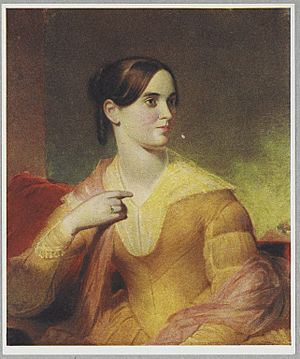John H. B. Latrobe facts for kids
John Hazlehurst Boneval Latrobe (1803–1891) was an American lawyer and inventor. He is best known for inventing the Latrobe Stove. This stove was also called the "Baltimore Heater." It was a coal-fired heater made of cast iron. It was designed to fit inside fireplaces. John Latrobe received a patent for his design in 1846. These small stoves became very popular by the 1870s. They were much smaller than the famous Benjamin Franklin's Franklin stove.
Contents
John Latrobe's Early Life
John Latrobe was the son of Benjamin Henry Latrobe, a well-known engineer and architect. John went to the U.S. Military Academy at West Point, New York. He studied engineering there from 1818 to 1821. However, he later chose to become a lawyer. After his father passed away, he returned to Baltimore. There, he studied law under Robert Goodloe Harper. John Latrobe married twice and had several children.
His Career as a Lawyer
After becoming a lawyer in Maryland, John Latrobe first worked with his younger brother. His brother, Benjamin Henry Latrobe II, later focused on civil engineering. John H.B. Latrobe then became a lawyer for the Baltimore and Ohio Railroad. He helped the railroad buy land for its expansion. He also helped set up their telegraph service. For many years, he was the railroad's chief lawyer. He even traveled to Russia to help with money matters before the American Civil War.
John Latrobe was elected to the American Philosophical Society in 1854. As a patent lawyer, he was modest about his stove invention. He worried that being known as a stove inventor might harm his legal reputation. By 1878, over 300,000 of his stoves were in use. Today, antique Latrobe stoves are mostly collected for decoration. They are rarely used for heating.
Community Involvement and Other Talents
John Latrobe was a strong supporter of the idea to help freed slaves move to Africa. He served as president of the American Colonization Society from 1853 until his death in 1891. He also helped start the Maryland Historical Society. He was its president for a time. He also helped found the American Bar Association, a group for lawyers.
In 1854, Latrobe gave a speech about the history of the Mason–Dixon line. This speech was printed many times. He also helped create Druid Hill Park in Baltimore. He served on its board of directors from 1860 until he died. Besides his legal work, Latrobe was also a poet and a painter. He was one of three judges who awarded Edgar Allan Poe a prize for his story "Manuscript in a bottle." This story was published in a Baltimore newspaper and helped start Poe's writing career.
Later Life and Legacy
John Latrobe passed away in 1891. He was buried with his family in Green Mount Cemetery in Baltimore. He gave his family's papers, including his own autobiography, to Maryland's State Archives. These papers are still kept there today. His home in Baltimore still stands across from the Catholic Basilica. His father had designed this basilica.
John Latrobe's son, Ferdinand C. Latrobe (1833–1911), also became a lawyer and author. He served in the Maryland legislature. He was also elected mayor of Baltimore seven times.



